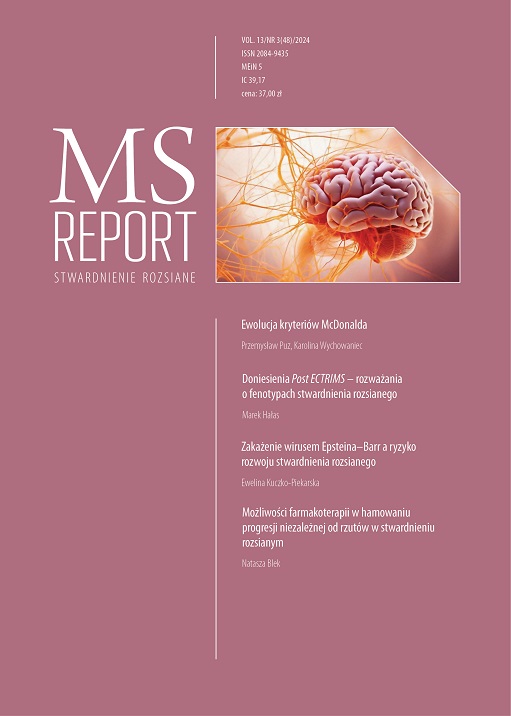Epstein–Barr virus infection and the risk of developing multiple sclerosis Review article
Main Article Content
Abstract
Despite increasing amounts of data regarding the pathogenesis of multiple sclerosis (MS), its etiology remains unknown. MS is believed to develop by interplay of genetic predispositions and environmental factors, including infectious ones, which disturb proper immune surveillance. More and more data indicate that the infectious agent is the Epstein–Barr virus (EBV). Although infection with it is usually asymptomatic in childhood, the ability of the virus to convert into a latent form with limited gene expression allows it to avoid host immune surveillance. It initiates a cascade of immunological processes leading to severe clinical implications, e.g., in the development of autoimmune diseases. Previous studies have shown that anti-EBV antibodies exist in almost all patients with multiple sclerosis. The most extensive population-based study in recent years covered US Army conscripts and found that the risk of developing multiple sclerosis is 32 times higher after infection with this virus. Determining the exact relationship between the Epstein–Barr virus and multiple sclerosis, including assessing the influence of genetic and environmental factors on this correlation, may be very important for understanding pathogenesis of multiple sclerosis and other autoimmune diseases. Such insights will also enable the identification of targets for future personalized therapies, especially in the context of increasingly widely used B cell depletion therapies.
Article Details
Copyright © by Medical Education. All rights reserved.
References
2. Hedström AK. Risk factors for multiple sclerosis in the context of Epstein-Barr virus infection. Front Immunol. 2023; 14: 1212676.
3. Houen G, Trier NH. Epstein-Barr Virus and Systemic Autoimmune Diseases. Front Immunol. 2021; 11: 587380.
4. Szczeklik A, Gajewski P. Interna Szczeklika 2017. Wydawnictwo Medycyna Praktyczna, 2017.
5. Bjornevik K, Cortese M, Healy BC et al. Longitudinal analysis reveals high prevalence of Epstein-Barr virus associated with multiple sclerosis. Science. 2022; 375(6578): 296-301.
6. MS International Federation. Epstein-Barr virus and multiple sclerosis.
7. Moutsianas L, Jostins L, Beecham AH. Class II HLA interactions modulate genetic risk for multiple sclerosis. Nat Genet. 2015; 47(10): 1107-13.
8. Hedström AK, Huang J, Michel A. High Levels of Epstein-Barr Virus Nuclear Antigen-1-Specific Antibodies and Infectious Mononucleosis Act Both Independently and Synergistically to Increase Multiple Sclerosis Risk. Front Neurol. 2020; 10: 1368.
9. Hedström AK, Huang J, Brenner N. Low sun exposure acts synergistically with high Epstein-Barr nuclear antigen 1 (EBNA-1) antibody levels in multiple sclerosis etiology. Eur J Neurol. 2021; 28(12): 4146-52.
10. Hedström AK, Huang J, Brenner N et al. Smoking and Epstein–Barr virus infection in multiple sclerosis development. Sci Rep. 2020; 10: 10960.
11. Hedström AK, Brenner N, Butt J et al. Overweight/obesity in young adulthood interacts with aspects of EBV infection in MS etiology. Neurol Neuroimmunol Neuroinflamm. 2020; 8(1): e912.
12. Rød B, Wergeland S, Bjørnevik K. Humoral response to Epstein-Barr virus in patients with multiple sclerosis treated with B cell depletion therapy. Multiple Sclerosis and Related Disorders. 2023; 79; 105037.
13. Sun C, Chen X, Kang Y et al. The Status and Prospects of Epstein-Barr Virus Prophylactic Vaccine Development Front Immunol. 2021; 12: 677027.
14. Edwards KR, Schmidt K, Homad LJ et al. Vaccination with nanoparticles displaying gH/gL from Epstein-Barr virus elicits limited cross-protection against rhesus lymphocryptovirus. Cell Rep Med. 2024; 5(6): 101587.

